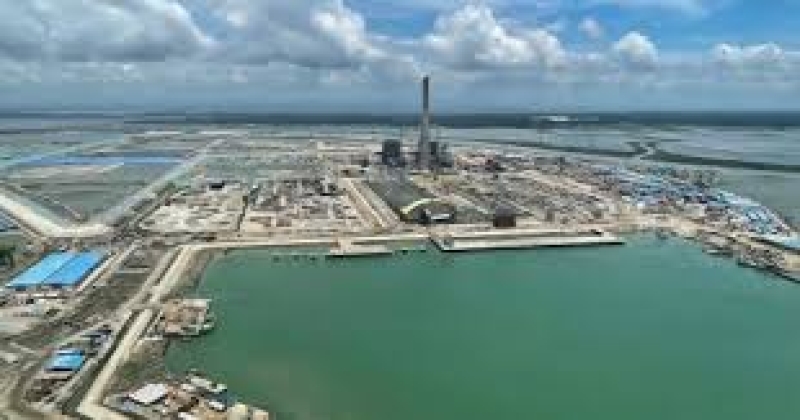- Xi unveils vision for equitable global governance, rejects unilateralism |
- EU Warns Xi-Putin-Kim Alliance a Challenge to World Order |
- Matarbari Project Set to Create 2.5m Jobs, Boost Economy |
- 4,000 ASIs to Be Recruited Ahead of Polls, Says IGP |
- World Heritage Sites Face Rising Water Risks from Climate Change |
MIDA to turn Moheshkhali-Matarbari into trade hub

A successful implementation of Moheshkhali–Matarbari Integrated Development Initiative (MIDA), planned as a core to develop one of the largest commercial hubs in Bangladesh, could bring about a considerable impact to the economy of Bangladesh, officials said on Wednesday.
It brings logistics, energy and power, manufacturing and fishing industry to one location, according to the MIDA Strategic Vision shared by the Chief Adviser’s press wing.
Simply put, the idea is to combine deep sea port facilities with energy terminals, power plants and economic zones so that industries can operate close to their source of fuel and with logistics support, the document reads.
The Matarbari-Moheshkhali region was chosen for such a multifaceted project owing to several competitive factors: necessary draft for deep sea port; proximate land to build synergic ecosystem of for power, energy, manufacturing & heavy industry, marine & fishing.
The ambition is to build an integrated economic hub for trade and investment leveraging direct access to international shipping lines is central to improve competitiveness and future growth.
A study by JICA suggests investment of USD 60-65 billion in the next 20-30 years.
Private investment is anticipated at USD ~47-48 Bn, of which 10% (USD 4.8Bn) is targeted FDI investment.
The total GDP impact is projected at USD ~150 Bn. Of that amount, direct GDP impact will be USD ~70-75 Bn.
This is backed by the creation of ~1.5 lakh direct jobs (~25 lakh direct + indirect) in the long term. Further, this region will become an essential element for long term sustainability of Cox’s Bazar’s regional economy, resulting in 1.5X the current tourist footfall in the region.
This execution consists of 4 main pillars: port and logistics, manufacturing, power and energy, fishing.
There has been ongoing revision and consultation regarding the portfolio mix of these pillars to tap into the geographical advantage meaningfully, according to the MIDA Strategic Vision.
The four pillars will also be sustained by supporting physical and social infrastructure, including a tourism zone at Matarbari.
Each of the pillars have both short and long-term strategies, along with economic impact, which are briefed below.
The first pillar of the initiative is the deep sea port and its connected logistics system.
This part of the project is designed to handle both bulk cargo and containers in a way that current ports in Bangladesh cannot.
The port at Matarbari is built with a natural depth of about 18.5 meters, which allows large ships to dock directly.
This is a significant change from Chattogram where smaller vessels are required and goods need to be moved in several steps.
These changes will allow a projected increase in port capacity by ~50% in the next 30 years.
With the advantage of the natural depth, it is estimated that Matarbari will cater to ~25% of the country's bulk traffic and -45% of container traffic.
Saving up here will have spillover effects in the cost of other essential commodities.
For instance, this reduction in shipping cost can reduce the cost of a 12kg LPG cylinder in Bangladesh by ~Tk 50.
The risk-factored numbers were procured with a few developments underway - container freight stations, widening to four-lane roads, Intermodal Container Yard at Chakaria to double-line rail connectivity till Dhaka to name a few.
Subsequent large-scale ship building, recycling, and steel manufacturing prospects are also being considered.
Since the deep-sea port is bringing about cost competitiveness for both bulk and containerised goods, the synergy of a manufacturing hub comes naturally.
Large volumes of industrial commodities will be traded via the Matarbari port, providing ready feedstock for manufacturing.
After three stages of scrutiny, nine suitable industries were identified including steel, agro and food processing, automobile, electronics, etc.
Additionally, pharmaceuticals and API, synthetic fibres, and shipbuilding were identified for export diversification.
Overall, Balance of Payment savings equivalent of USD ~6 Bn could be achieved in the long term.
Attracting the right investments with a package deal of deep-sea logistics and captive power, the hub is expected to directly contribute to ~10% of Bangladesh’s manufacturing output by the next 30 years.
The third pillar is developed keeping the ~6.7% CAGR of power demand in mind.
Being significantly import dependent and affected by global price volatility, Bangladesh aims to generate 90% of power demand on its own in the long term. With that end, the plan for a power generation hub was devised, reports UNB.
The mix of traditional and new power sources are to be developed shortly.

